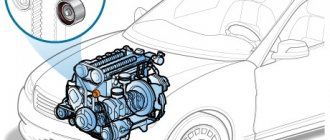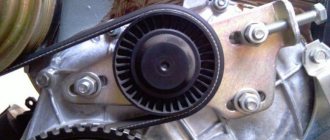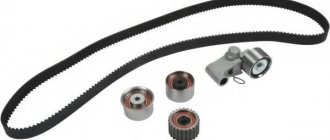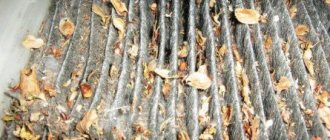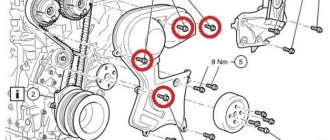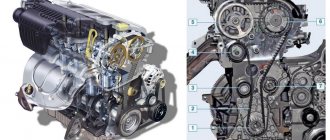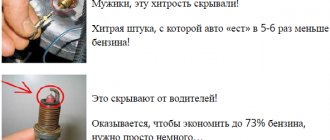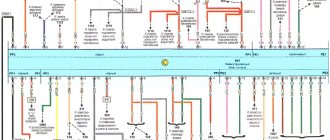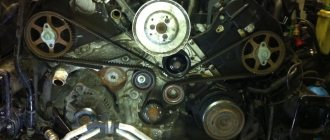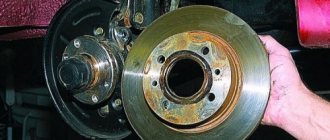Renault Duster: when to change the timing belt
On the mega-popular urban crossover Renault Duster, the timing belt must be replaced, according to regulations, every 60 thousand kilometers, or every 4 years. Replacement is carried out even if the belt is in satisfactory condition and there are no external signs of damage (cracks, breaks). Also, every car owner should know that during the life of the timing belt, its condition must be checked. The Renault Duster manufacturer recommends checking the timing belt every 15 thousand kilometers.
How to inspect the timing belt on a Renault Duster
The timing belt can be found under the hood of your car. The Duster is equipped with a rubber belt, the inner surface of which has teeth. The belt covers several pulleys at once; in addition to the camshaft and crankshaft, the timing belt also covers some auxiliary units of the timing system. As a result, the belt experiences enormous loads during operation, which affects its performance and service life.
To check the integrity of the timing belt on a Renault Duster, it is enough to visually assess the condition of its surface for the presence of peeling, folds, and cracks (mainly from the teeth side). There should also be no obvious signs of wear at the end of the belt.
Signs of timing belt wear:
- Cracks in the timing belt
- Peeling on the surface of the belt
- Folds on the side of the teeth
- Loosening the end
Installed motors
The year of birth of this car is considered to be 2010, when it first appeared before potential owners. Owners and many automotive experts consider this car unique in its capabilities in its class. It is a light crossover, which has very high maneuverability, has good cross-country ability on unimproved roads, and consumes a relatively small amount of fuel.
The Renault Duster can be purchased with both all-wheel drive and front-wheel drive. The car with all-wheel drive is equipped with a gearbox that has 6 gear shift stages. This allows you to move in comfort on roads of different technical conditions. The first models used the K4M engine as a power unit, later it was replaced by the H4M. A chain or belt is used to drive the timing mechanism.
Motor K4M
The K4M power unit has a displacement of 1600 cm3, has several different modifications, and is intended for installation on cars of this concern. The basis for this engine was the K7M engine, which received a new cylinder head with 16 valves. To drive them, two camshafts were installed, which turned out to be lightweight, and their own pistons were also developed. The thermal clearance in the valve mechanism is regulated by hydraulic compensators.
A number of engines are produced with a phase regulator; the compression ratio of the working mixture can be from 9.5 to 10 units. The power unit power declared by the manufacturers is 102 hp, but some modifications can produce 135 hp with the same displacement.
A timing belt is used to drive the timing mechanism. This requires strict adherence to all factory recommendations for engine maintenance, since a broken toothed belt leads to damage to the valve mechanism. In this case, an expensive overhaul of the engine will be required.
Motor N4M
In 2006, production of a new engine began, which replaced the well-known K4M. The improvements affected many components and parts. So, with the same working volume, the compression ratio became 10.7, this allowed the output to have power from 108 to 116 hp.
In the timing mechanism drive, the toothed belt was replaced with a metal chain. The thermal clearance of the valve mechanism is periodically adjusted every 80–100 thousand kilometers by selecting the thickness of the pushers. The appearance of third-party sounds under the valve mechanism cover is a clear sign that the thermal clearance needs to be adjusted.
The engine is not critical to the choice of fuel; it works equally well on both 95 and 92 gasoline. Some engine modifications have two injectors on each working cylinder. And you can also change the valve timing; a phase shifter is installed in the intake tract; the throttle valve of this engine is electronic. The designers made sure that the engine complies with Euro 5 standards. It is possible to tune the power unit in various ways.
Renault Duster diesel: timing belt replacement
Replacing the timing belt on a Renault Duster can be done at a service center or on your own. In the second case, it is important to take into account that in the toothed pulleys of the Renault Duster engine with the 1.6, 2.0 engine there are no marks according to which the engine timing phases are set. To install phases, services use special equipment, which, among other things, allows you to fix the crankshaft and camshaft.
Along with the belt, the manufacturer recommends replacing the tensioner, support roller and pulley bolt for auxiliary units. The process of replacing the timing belt depends on the make and type of engine of the car. Let's consider the replacement process using the example of a diesel Renault Duster (in other modifications of the car - Duster 1.6, 2.0 liters - there are some differences in the belt measurement process, but they are not significant).
During the work process, it is convenient to use a tool for replacing the Renault Duster timing belt. It is usually included in the timing kit.
Replacing the timing belt on a diesel Renault Duster:
- It is more convenient to replace the timing belt on a lift, since during the process you will have to jack up the engine
- Removing the pistons: insert a screwdriver into the slot and turn counterclockwise until the center part lifts up. Next, use a second, thinner screwdriver to pry it up and pull it up, after which the piston can be freely removed
- Remove the right wheel from the car, as well as the front part of the fender liner
- To remove the fender liner pistons, you need to screw a self-tapping screw of a suitable size into the central hole of the piston and use pliers to remove it
- Next, you need to loosen the pulley bolt on the crankshaft: you will need an assistant for this procedure. He must sit in the driver's seat, engage 5th gear and press the brake all the way, while the second person will be required to unscrew the bolt with a wrench
- Remove engine protection
- Remove the clamp and hose in order to drain the antifreeze (drain into a container prepared in advance)
- Remove the belt from the auxiliary units - if the tension of the roller cannot be loosened using a wrench, you need to pull the lower branch of the belt down and jam the roller with any piece of wood, after which you can remove the belt
- Place something suitable under the pallet and support the engine.
- Unscrew and remove the upper engine mounts
- Remove the plastic casing from the timing belt (it has two parts - upper and lower) - unfasten the latches and unscrew the plastic pin; to do this, by lowering and raising the engine you will need to align the holes in the tray
- Unscrew the aluminum support and lift the engine up as much as possible
- Bend back and remove the timing belt
- On your Renault Duster, you need to set the timing belt marks: they are set by aligning the holes on the camshaft in the pulley and head - you need to insert a steel rod of a suitable diameter (a drill will do) and mark with a marker how the crankshaft pulley and the injection pump pulley fit in
- The manipulations with the belt marks described below can only be carried out if the marks have not been knocked down. If the marks are knocked down, you need to screw in the crankshaft stopper as described in the manual
- The crankshaft key should point to 12 o'clock - opposite you need to make a mark with a marker
- There should be 19 belt grooves between the marks
- It is necessary to loosen the timing belt tension roller, after which the timing belt can be removed
Replacing the pump on Renault Duster diesel:
- Remove the cover
- Remove the generator or injection pump pulley
To remove the generator, you need to disconnect the wires from the generator, unscrew the top bolt and loosen the bottom, and then tilt the generator to the side. Afterwards you can remove the pump.
Next, you can install a new timing belt, observing the marks and tensioning the roller. After installing the belt in place, it is necessary to slowly turn the crankshaft to check the marks. Then you can reassemble in reverse order.
It is important to bleed air through the screw plugs of the pipes after refilling the antifreeze.
Renault Duster timing belt replacement cost
The price for replacing a Renault Duster timing belt at an official service center is 23 thousand rubles. The price for a timing belt will be from 2,200 rubles. up to 3,800 rub. A set of a belt and two rollers can be purchased for RUB 3,500.
Drawing conclusions
So, replacing the timing belt on a Renault Duster 2.0 on your own is not a very complicated process, which will save some money and avoid unexpected breakdowns.
Replacing the timing belt Renault Duster 2.0
a rather labor-intensive operation requiring additional devices. In addition, the 2-liter Renault Duster gasoline engine does not have timing marks on the camshaft pulleys, which certainly complicates the work. According to the manufacturer's regulations, the belt must be replaced once every 60 thousand kilometers or once every 4 years, whichever comes first.
Before starting work, you must understand that this engine does not have installation marks on the camshaft pulleys, so we carefully read this article so as not to bend the valves after incorrect assembly. First, let's take a close look at the Duster 2.0 timing diagram in the next photo.
Before you begin replacing the belt and removing the covers, you will have to remove the engine mount. But before removal, the power unit itself must be “suspended.” To do this, insert a wooden block between the engine oil pan and the subframe so that the right support of the power unit no longer supports the weight of the unit. To do this, use a wide mounting blade to slightly lift the engine and insert a piece of wood, as in the photo.
We remove from the holders located on the Renault Duster engine support bracket the fuel supply tubes to the ramp and the fuel vapor supply to the receiver. Remove the wire harness holder from the support bracket hole. Using a 16mm socket, unscrew the three bolts securing the support bracket to the upper timing cover. Using the same tool, unscrew the three bolts securing the support to the body. Remove the right power unit support.
Now we need to get to the belt. Using a 13mm socket, unscrew the three bolts and nuts securing the upper timing cover. Remove the upper timing cover.
Checking the timing belt tension
. When installing a new timing belt, you will need to properly adjust the tensioner. For this purpose, there are special marks on the tension roller.
When the belt tension is normal, the movable indicator should coincide with the recess of the stationary indicator of the tension roller. To adjust the correct belt tension, you will need a wrench set to “10” and a hexagonal wrench set to “6”.
When installing a new belt, use a 10mm spanner to loosen the tightening of the tension roller mounting nut and use a 6mm hexagon to turn the roller clockwise (tensioning the belt) until the pointers align. But until this point, you still have to remove the old belt and install a new one.
The first and most important step is to unscrew the crankshaft pulley bolt. To do this, you need to block the pulley from turning. You can ask an assistant to engage fifth gear and apply the brake, but if this method does not work, there is an alternative option.
We take out the piston that secures the plastic holder of the wiring harnesses to the clutch housing. We remove the holder with the wiring harnesses from the clutch housing. Now you can take a slotted screwdriver and put it between the teeth of the flywheel ring.
Usually this method helps to unscrew the bolt quite quickly.
Using the “8” head, unscrew the five bolts securing the lower timing cover.
Before removing the timing belt, it is necessary to set the crankshaft and camshafts to the TDC (top dead center) position of the compression stroke of the 1st cylinder. Now we need to block the crankshaft from turning. To do this, use the E-14 head to unscrew the special technological plug in the cylinder block.
We insert an installation pin into the hole in the cylinder block - a rod with a diameter of 8 mm and a length of at least 70 mm (you can use the shank of a drill with a diameter of 8 mm). This will block the crankshaft from turning when replacing the timing belt of a Renault Duster with a 2-liter engine.
When the crankshaft is in the TDC position of the pistons of the 1st and 4th cylinders, the finger must enter the rectangular groove on the cheek of the crankshaft and block the shaft when trying to turn it in one direction or another. When the crankshaft is in the correct position, the keyway on its toe should be located between the two ribs of the cylinder block cover. Photo below.
In order to block the camshafts from turning, we perform the following operations. To block the camshafts, it is necessary to remove the plastic plugs at the left end of the cylinder head. Why do we remove the air path resonator? You can simply pierce the plastic plugs with a screwdriver, although you will have to put new plugs in there later.
After removing the plugs, it turns out that the ends of the camshafts have slots. In the photo we will mark them with red arrows.
These slots will help us block the camshafts from turning. True, for this you will have to make a “U” shaped plate from a piece of metal. The dimensions of the plate are in our photo below.
Now you can safely remove the belt and install a new one. Use a 10mm wrench to loosen the tension roller nut. Using a “6” hexagon, turn the roller counterclockwise, loosening the belt tension. We remove the belt and also replace the tension and support rollers. The new belt should have 126 teeth and a width of 25.4 mm. When installing, pay attention to the arrows on the belt; these are the directions of belt movement (clockwise).
When installing a new tension roller, the bent end of its bracket should fit into the recess of the cylinder head. Let's look at the photo for clarity.
We install the belt on the toothed pulleys of the crankshaft and camshafts. We place the front branch of the belt under the coolant pump pulley, and the rear branch under the tension and support rollers. We adjust the tension of the timing belt (see above). We remove the mounting pin from the hole in the cylinder block and remove the device for fixing the camshafts. We turn the crankshaft two turns clockwise until the grooves on the ends of the camshafts take the desired position (see above). We check the valve timing and belt tension and, if necessary, repeat the adjustments. Reinstall the screw plug and press in new camshaft plugs. We perform further engine assembly in reverse order.
In accordance with the maintenance regulations, we replace the Renault Duster timing belt every 60 thousand km of the vehicle or after 4 years, whichever comes first), regardless of its condition. Belt failure (breakage or shearing of teeth) will lead to sticking of the valves into the pistons due to mismatch between the rotation angles of the crankshaft and camshafts and as a consequence. to expensive engine repairs. Therefore, we recommend checking the condition of the belt during every vehicle maintenance.
We carry out the work on an inspection ditch or overpass.
Which timing belt to install on Renault Duster
Original Renault timing belt:
- 27mm – article number 1238200366318
- RENAULT - article number 8201069699
Analogues of the Renault Duster timing belt:
- Gates – article number 5578XS
- Contitech - article number CT1035
- BOSCH – article number 1 987 949 565
- GoodYear - article G1545H
- Hutchinson - item 123 HTDP 27
- Dayco – article number 94944
- Flennor - article 4467V
Timing roller:
- Gates – article number T43014
- Hutchinson - article number HTG 121
- INA – article number 531 0547 10
- LPR – article number AA10146
- Ruville - article 55581
- Sasic – article number 1704005
- SNR – article number GT355.39
- Triscan – article number 8646 10123
- Flennor – article number FS05091
- Mapco - article 23190
Timing kit (belt + roller):
- Original Renault - article number 7701 477 028
- Gates – article number K025578XS
- Contitech – article number CT1035K2
- Dayco – article number KTB474
- Bosch - article number 1 987 948 948
- INA – article number 530 0197 10
Timing pump:
- Original Renault - article number 7701 475 995
- Airtex - article 1746
- Quinton Hazell - item QCP3629
- Graf – article PA977
- Hepu - article P 962
